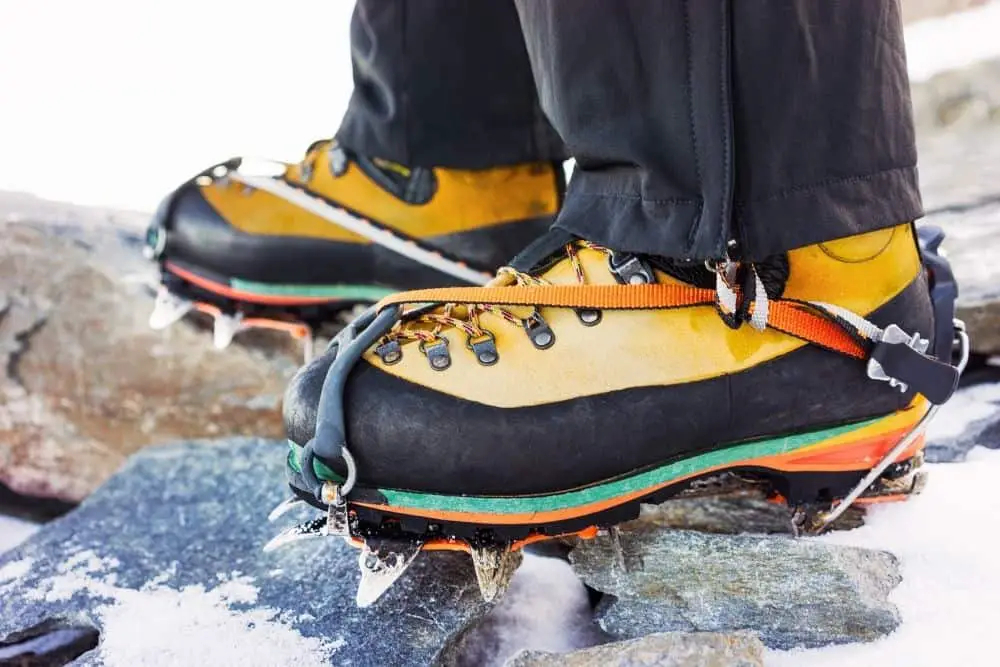Hiking is an enjoyable activity, and one of the most fun parts is the feeling of adventure attached to it. Regular hikers would have taken hikes on various terrains or in various weather conditions at some point.
Whichever may be the case, hikers know how important safety is on the trail, and one way you can ensure safety is through traction. Traction on the trail is very important; when it is not there, you could imagine the incoming disaster.
You could end up with a bleeding nose or body, a broken bone, or just be a mess at the end of the hiking trip. Thankfully, hiking boots’ manufacturers put some features in place to ensure adequate traction on the trail; the sole.
As you know, hiking boots’ soles are rigid, flexible, and have lug patterns that help you grip different terrains and hike safely. But, what happens when they are not?
You need to make up for that. And one of the ways some people make up for traction on different terrains is through crampons, especially for activities other than hiking.
The question is, can you wear crampons with hiking boots, and are they even compatible at all? Their functions are all good, but can you use them on the trail and when?
Let’s find out!
Contents
Can You Wear Crampons With Hiking Boots?
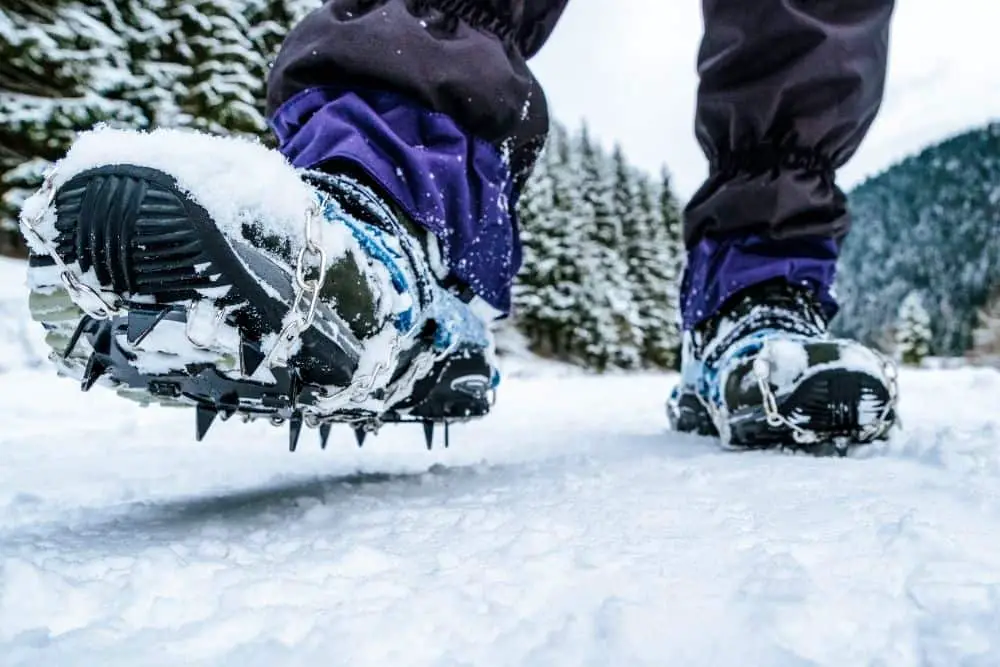
Crampons are traction devices that people use to enhance their foot grip for different activities. Therefore, if you need more traction than your hiking boots can provide on the trail, wearing crampons is one way to do so.
And that answers the question, “Can you wear crampons with hiking boots?” because you totally can. People wear crampons to enhance mobility on ice, snow, and for climbing.
More than that, some other people wear them for crossing glaciers, icefields, snowfields, walking up and down slopes, traveling on snow and ice, and more. In addition, they have been in use for over a century by ice climbers and mountaineers.
Moreover, there are different types of crampons, and you don’t get to use all of them with your hiking boots. For example, there are the mountaineers, or technical crampons and trail crampons.
These crampons are made from steel, aluminum, or stainless steel, and their usage differs. Technical crampons are mostly for more intense use in ice climbing to keep the user steady.
Therefore, you probably won’t need this as a hiker, especially if you don’t intend to do some ice climbing on the trail. Then, there are the trail crampons, which you are more likely to use as a hiker.
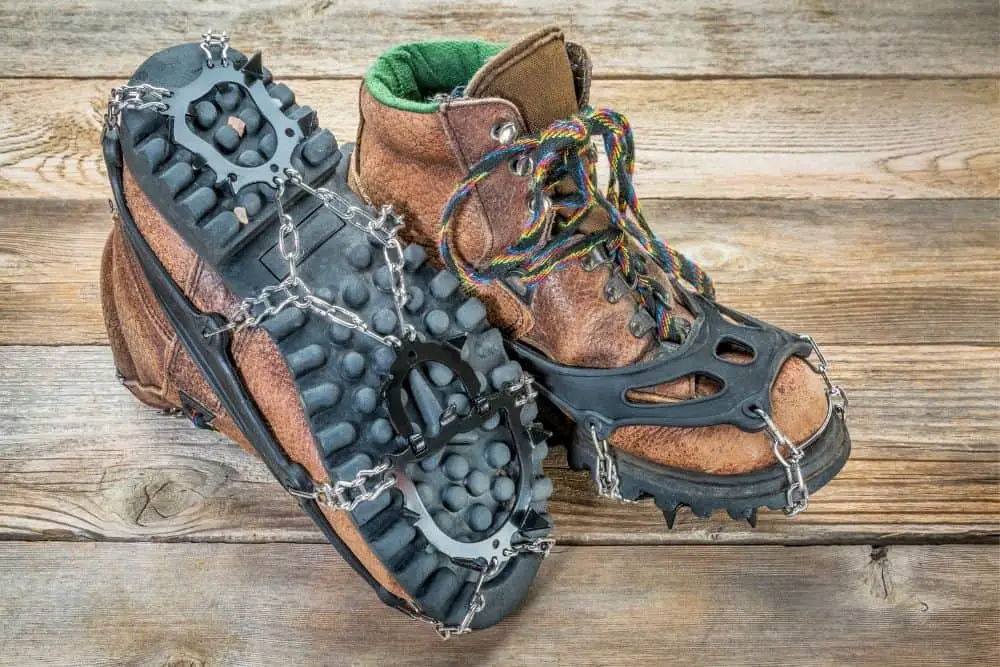
Generally, crampons have features like spikes, heel clips, adjustable toe baskets, flex bars, straps, anti-balling plates, and more. These features have different roles they play in ensuring that each step you take on the terrain is safe.
Usually, the spikes are between 10 and 14, and they are usually 1 to 2 inches long, depending on their intended use. The heel clip works by locking the boots’ heel welt, while the strap ensures that the crampons are in place and don’t come off while on the trail.
Then, the flex bar allows the length of the crampons to be adjusted to the length of the boots. Why do you need to wear crampons with hiking boots? Majorly, they help to secure your footing on dangerous trails, so you don’t slip, trip, or fall and injure yourself.
When hiking on slippery terrain, you are at risk of broken bones, fractures, muscle sprains, pain, injuries, concussions, and other worsening situations. While you probably won’t die from a fall on the trail, you can save yourself some stress, pain, and risk by enhancing your grip with crampons.
Where are you more likely to trip, slip and fall on the trail? That is icy, snowy, or sloped terrains. You need crampons with hiking boots on these terrains, so you don’t end up with an injury.
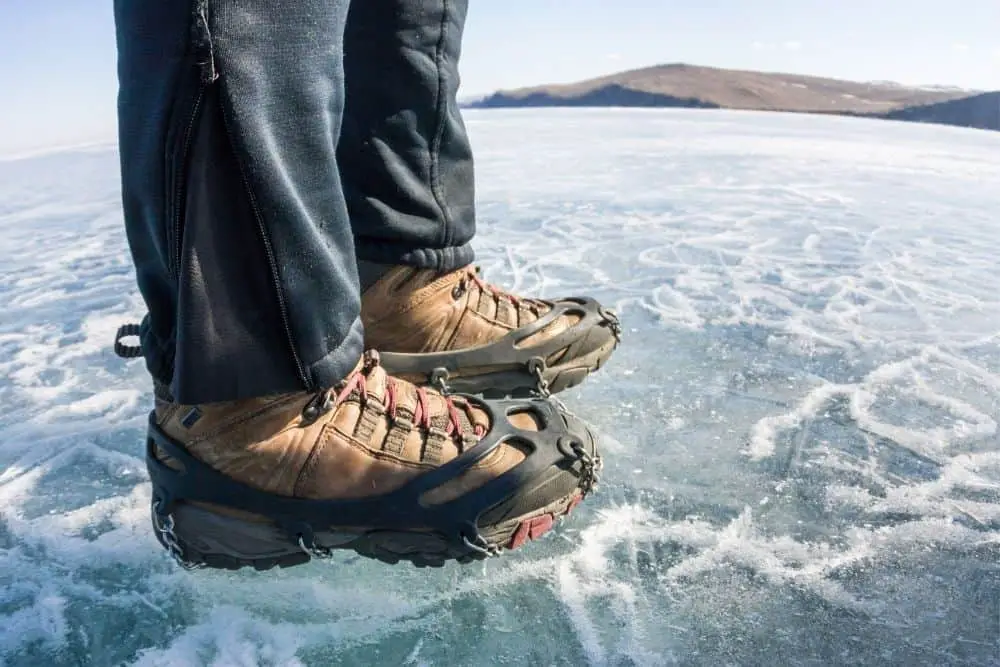
Not only would you need them on those trails, but you would also need to wear crampons with hiking boots during the snow. You had better bring your crampons when you hike in the snow so you don’t get stranded on the trail.
At first, the trail may not be covered in snow, but the longer you stay on the trail, the more snow can cover it up. Therefore, crampons will be useful for when you are going on or returning from your hike.
Are hiking boots compatible with crampons? Absolutely! Not only are crampons useful on the trail, but you can also wear them with some of your hiking boots.
They are compatible due to their spikes that help with traction. In addition, they have straps that are adjustable to the size of your hiking boots. They make hiking on ice, snow, and slippery terrain easier and safer.
You only need to find the one that works with your hiking boots. Generally, crampons work well with rigid and sturdy hiking boots meant for tough hiking situations.
Once you have those and your crampons, you can wear them together, set out on the trail, and enjoy your hike.
Benefits of wearing crampons with hiking boots
Earlier, we highlighted the possibility of wearing crampons with hiking boots. But, what are its benefits? Why should a hiker even consider wearing one? Let’s take a look.
Enhances traction
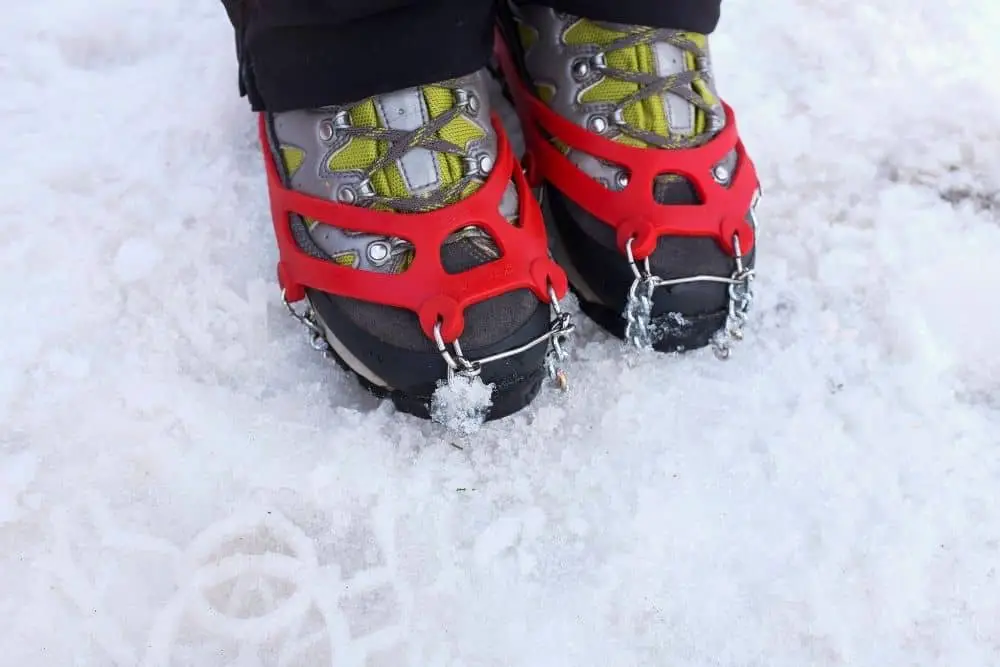
One of the benefits and functions of crampons is that they enhance traction. Your hiking boots’ soles ensure traction, but they could lack it on some trails, like icy or snowy ones.
With crampons, you can be sure to get more traction. Crampons have sharp, long spikes and are made from strong materials.
These spikes can dig deep into snow or ice and enhance grip on the trail. That is, they are anti-slip and more grippy than rubber soles that can fail on the trail.
Ensures safe hikes
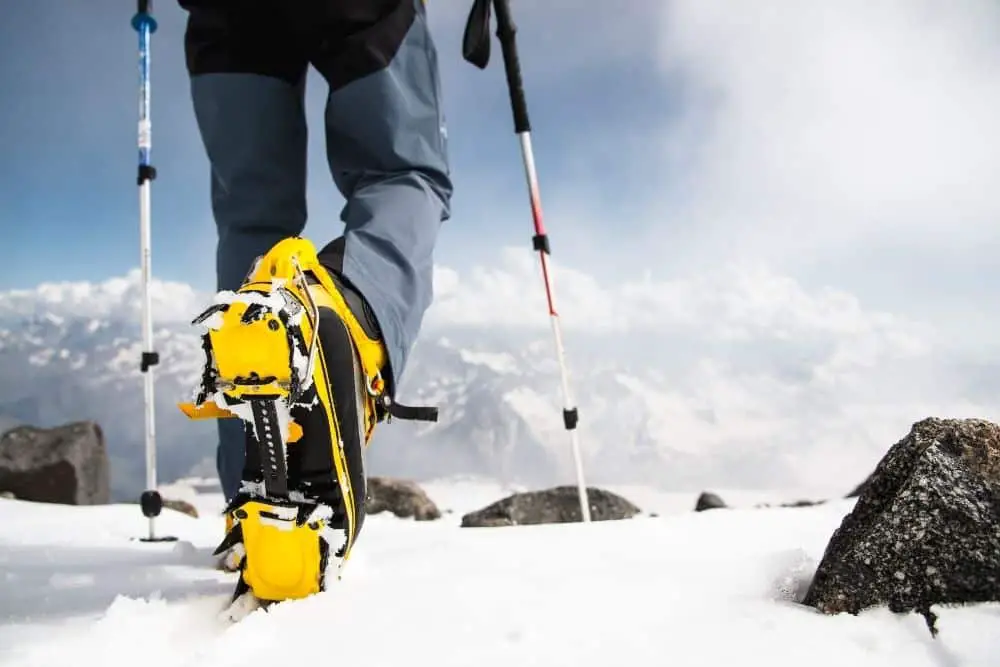
Another advantage of using crampons with hiking boots is that they help to ensure safer hikes on the trail. Imagine walking on ice and slipping down the slope or falling.
Crampons are super grippy on the trail. As long as your crampons can dig into the terrain, you can hike to and fro safely without sustaining any injury. And if you do have injuries or pain, it would be less likely for you to trip and fall on slippery terrain.
Can be durable

Crampons can last a great deal on the trail, which is somewhat associated with usage and the material they are made of. For example, stainless steel crampons are corrosive resistant, so they don’t quickly rust even though you use them on terrain filled with ice or snow.
In addition, steel crampons are also very durable due to their intended usage, like in technical, steep, and icy terrains.
Drawbacks of wearing crampons with hiking boots
Although the idea of crampons is all about aiding a hiker on a trail, it can sometimes pose some problems. However, these problems aren’t all that bad, but just some drawbacks that you need to consider before wearing crampons.
Add to weight on the trail

One drawback of wearing crampons with hiking boots is that they add to your weight on the trail. First, hiking boots already weigh some pounds on your feet, which could be a lot of work on their own.
Then, when you strap crampons on them, that is just adding extra weight to your feet, which could make you tire easily on the trail. Besides, crampons also weigh some pounds, and when you combine both weights together, it might just be a bit much for you, not to mention the weight on your back.
However, you could go for aluminum crampons, which weigh less than the other types, like steel and stainless steel, but they have less strength and durability.
May require training
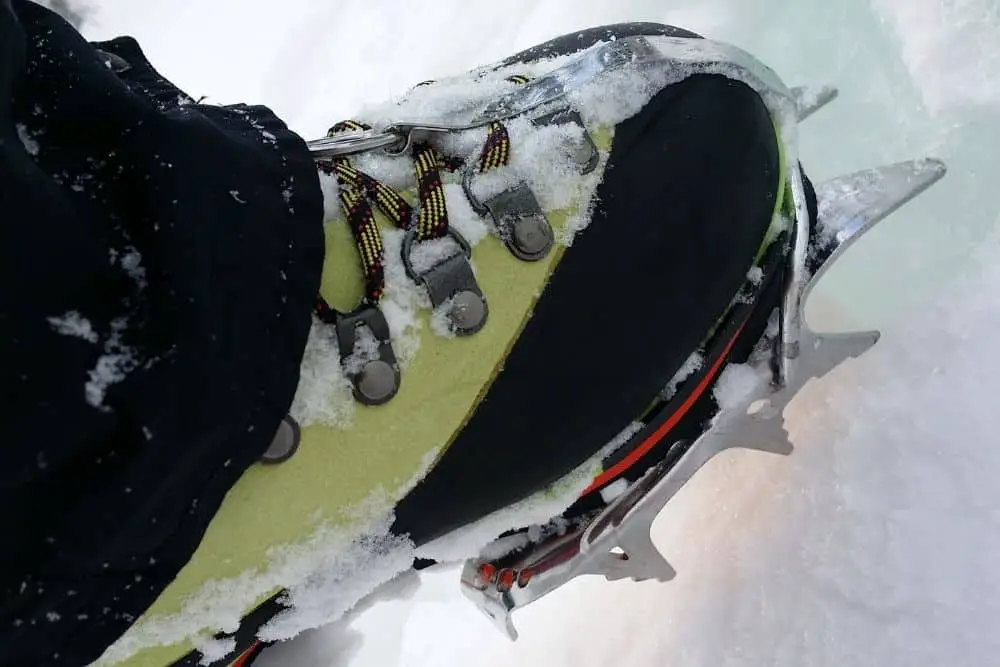
Another drawback to wearing crampons with hiking boots is that they are not easy to use, and it may require training on how to use them before setting out on the trail. As a beginner, wearing crampons on hiking boots may feel weird at first, and may be unbalancing.
And setting out on slippery terrain without knowing how to use it may be riskier than not wearing crampons at all. This is why you may need to train before setting out, especially for technical crampons.
You would need a guide’s help to master how to walk with them on the trail. But they are no big deal once you master how to use them.
It seems as though you are walking on plain terrain when you get a wing of it. Some people don’t need to train, but you had better train if you are not confident.
What Hiking Boots To Wear With Crampons?
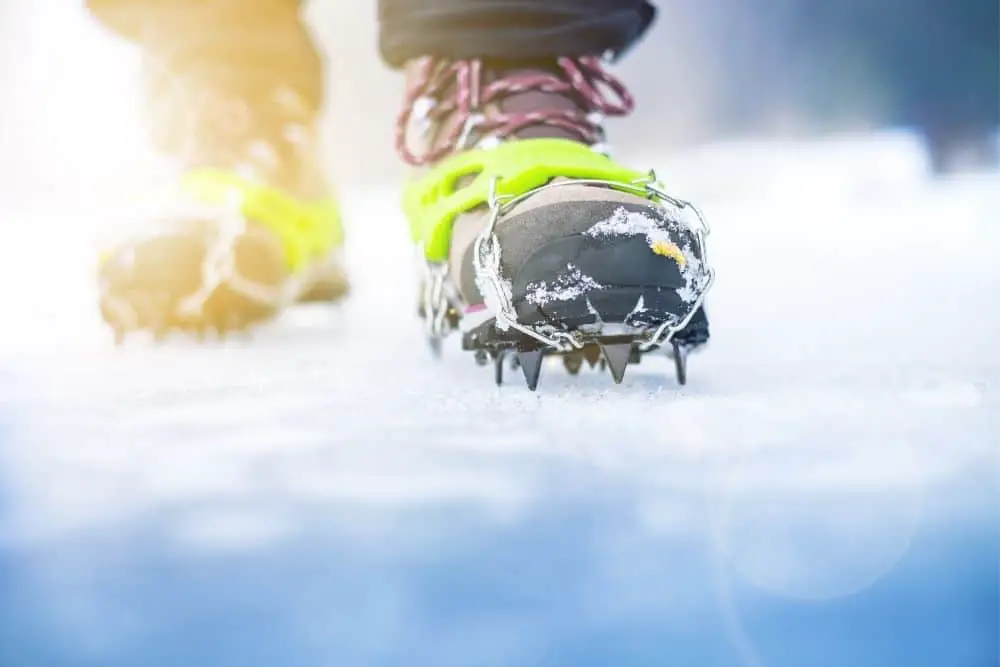
If you started this article with the question “are hiking boots compatible with crampons?”, we bet you already got your answer. We have settled that you can wear hiking boots with crampons.
However, the question still remains as to which hiking boots are compatible with crampons. To answer that, we would like to use the boots’ grading system.
Usually, boots are graded from B0 to B3. Because of their overly flexible soles and uppers, B0 hiking boots are completely incompatible with crampons.They are not solid enough to be used with crampons.
Crampons B1 to B3, on the other hand, are compatible with crampons. But what are they? Boots with rigid midsoles are B1, for example, while boots with stiff uppers and midsoles are B2.
Finally, B3 is the toughest, with the stiffest soles and uppers, for the toughest and most technical hikes. With that in mind, the types of hiking boots you can wear with crampons are:
1. Winter hiking boots
- WATERPROOF: These winter hiking boots for men and women are made of waterproof suede and synthetic...
- INSULATION: With 3M 200g thinsulate insulation inner material and removable 3M thinsulate insoles,...
- ANTI-SLIP OUTSOLE: Durable TPR shell and an outsole that is non-slip and tracked with textures,...
Last update on 2023-11-11 / Affiliate links / Images from Amazon Product Advertising API
These boots are mainly for winter hiking. For this reason, they have features like thick insulation, wind and water resistance, and non-slip outsoles.
Since crampons are mostly used on terrain like ice and snow, their waterproofness can ensure that your feet don’t get wet on the trail. Likewise, their wind-blocking features and insulation help to keep your feet warm.
More than that, the materials used in them help to make the uppers stiff, and coupled with their stiff and non-slip outsoles, they are rigid enough for crampons. Winter hiking boots are some of the best boots you can wear with crampons.
Their features, coupled with crampon functions, mean you can enjoy a safe and comfortable hike on the trail.
2. Backpacking boots
- Comfortableness: NORTIV 8 Men's Waterproof Hiking Boots certainly delivers on all-day comfort!...
- Lightweight and Flexible EVA midsoles: reduce foot fatigue. They are designed for long-lasting...
- Non-slip & Durable: High-quality rubber soles are fully slip-proof and feature advanced traction for...
Last update on 2023-11-10 / Affiliate links / Images from Amazon Product Advertising API
Other types of hiking boots you can wear with crampons on the trail are backpacking boots. They are strong, stiff, and rugged.
They are built to carry a heavyweight on the trail, so they are rigid enough to use with crampons. Their soles, midsoles, uppers, and designs are strong enough for you to walk with them on icy trails.
In addition, they have insulation and water resistance, which are good for the weather and terrain.
3. Mountaineering boots
Last update on 2023-11-10 / Affiliate links / Images from Amazon Product Advertising API
Crampons are very compatible with mountaineering boots. Initially, mountain and ice climbers used crampons, and since mountaineering boots are built for more rugged use and terrain, they are good to go.
They have stiff soles and uppers, which are part of the features your hiking boots need for use with crampons.
What Crampons To Wear With Hiking Boots?
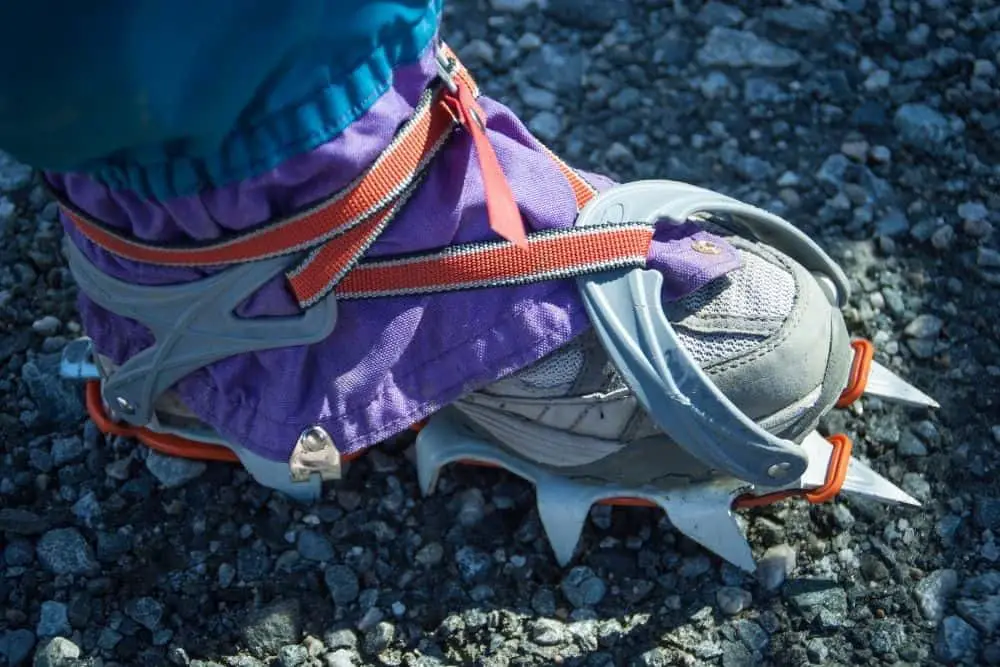
Just like boots have grades, crampons do as well. Rather than starting from 0, crampons start from C1 to C3. This grade covers the type that they are and their level of stiffness.
C1 crampons are strap-on crampons and the most flexible among the types. C2 crampons are hybrid crampons that are stiffer than 1.You would need to secure them to the heel welts of your hiking boots to properly use them.
Lastly, the C3 are step-in crampons and are the stiffest of the three. Therefore, the crampons you can wear with hiking boots are:
1. Aluminum crampons
- Lightweight 7075-series aluminum alloy frame. An adjustment bar linking front and back parts for a...
- Semi-rigid frame with its flexibility allows a degree of shock absorption and a greater resistance...
- Universal and durable strapping system for maximum versatility and fits most boots.
Last update on 2023-11-11 / Affiliate links / Images from Amazon Product Advertising API
Aluminum crampons are the lightest of the types, and you can use them with hiking boots. They are also very flexible, and you can use them on flat hiking trails, winter hiking, and glaciers.
You should wear them with hiking boots on plain paths covered with snow or ice, not on slopes or rocks. One disadvantage to them is that they are not as rugged as others, so they are not as durable, and this is why you should not use them on technical terrain.
2. Stainless steel crampons
- HIGH QUALITY STAINLESS STEEL SPIKES:Abrasion-resistant 19 multi-directional enhanced stainless steel...
- MORE SAFE AND DURABL:The link of this crampon use welding chain and more stronger stainless steel...
- REDUCE INJURY:Cover is made by Silicone,not the general TPR rubber,highly elastic and won't tear or...
Last update on 2023-11-11 / Affiliate links / Images from Amazon Product Advertising API
These crampons are stiff and good for ascending slopes in the snow. They are stronger than aluminum crampons, so you would need to wear them with hiking boots that are stiff and rigid, like B2 boots.
You should ensure that the hiking boots you wear with them are much stiffer than they are so they can take the impact of the trail on them.
3. Steel crampons
- Durable traction cleats fit over shoes and boots to provide superior traction on snow and ice on all...
- Patented Diamond Beads are made from case-hardened steel alloy strung on steel aircraft cable;...
- Natural rubber sling remains elastic and secure even in sub-zero temperatures; easy to put on and...
Last update on 2023-11-11 / Affiliate links / Images from Amazon Product Advertising API
Steel crampons are the stiffest of all, and they are good for technical terrains. You may not necessarily need to wear these crampons with hiking boots if you don’t intend to hike on steep icy slopes or technical routes.
They are most compatible with stiff, solid mountaineering boots that are stronger than them. However, they are heavy, and will increase the overall weight of your hiking boots.
How To Choose Crampons For Hiking Boots
Before setting out on the trail, you need to make sure that your hiking boots and crampons match. This is so as to enhance performance and safety on the trail.
Therefore, when choosing crampons for your hiking boots, the following are the things you should consider:
Consider your boot type
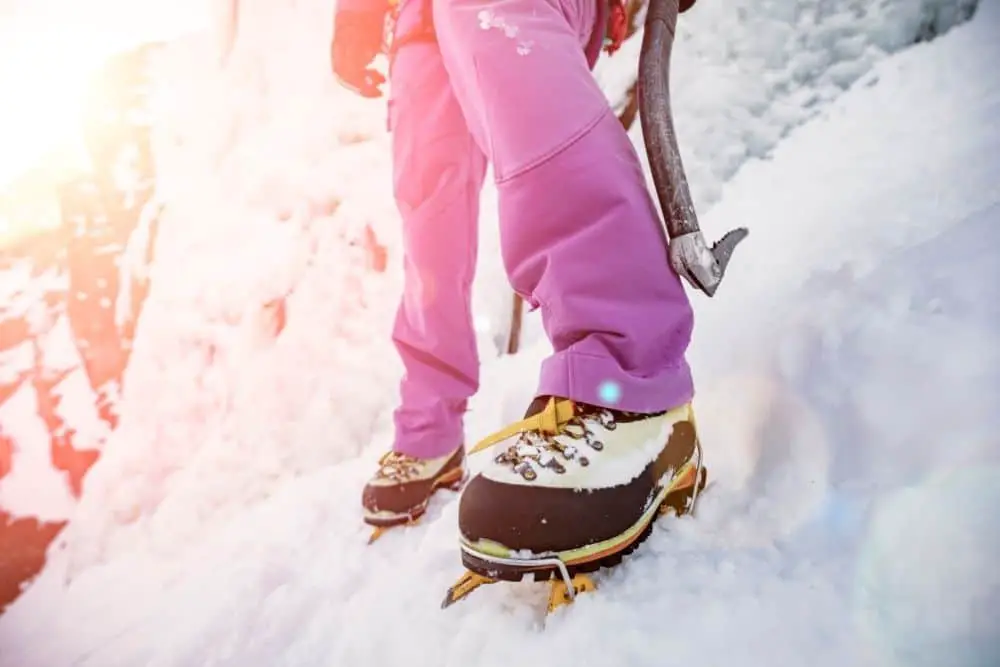
The first thing you should probably consider is your boot type. Are your hiking boots B0, 1, 2, or 3? The answer to that determines what kind of crampons to get for your hiking boots.
Your B1 boots are compatible with C1 crampons, while your B2 boots have C1 and 2 crampons. Then B3 boots are compatible with C1, 2, and 3 crampons. If your boots are B0, you should not get crampons for them; instead, you should get other hiking boots that rate higher than that.
Determine the activity
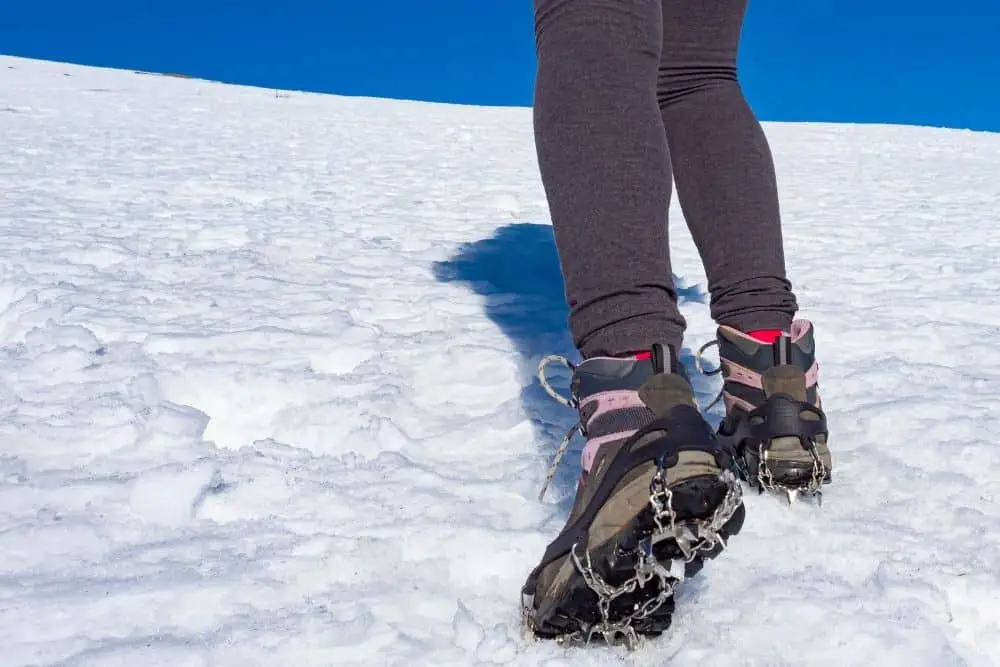
Then you need to determine the kind of hiking activity you are embarking on. Are you hiking up a slope, walking on plain paths covered with ice, on rocks, or mountaineering?
If your hike is not so technical, C1 crampons are good, flexible, and not so stiff. However, if it is more technical, C2 or 3 is better.
Hiking boots and crampons flexibility should match
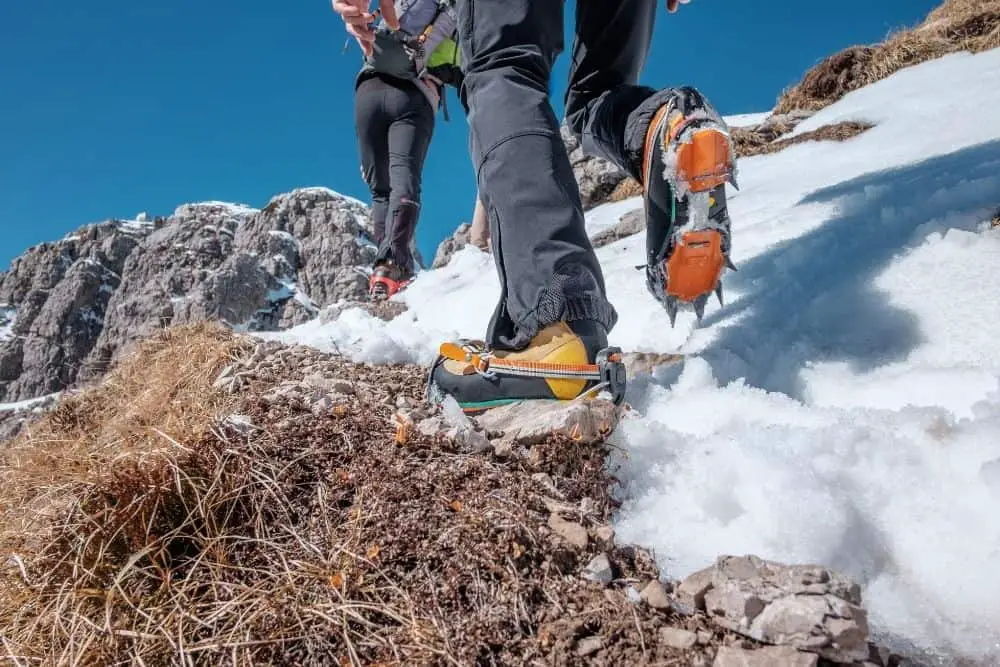
When choosing crampons, you should also let your hiking boots and crampons’ flexibility match. This will help the crampon stay on the hiking boots and not fall off when on the trail.
Flexible should go with flexible; likewise, stiffness should be the same.
Take your boots shopping

When you go shopping for crampons for your hiking boots, you should take your boots along so you can get the perfect fit. For flexibility, you should ensure the center bar fits perfectly.
In addition, the shape and length of both the crampons and hiking boots should match. You can make adjustments to the toe bail as time goes on to match the situation and fit.
Go with strap-on crampons
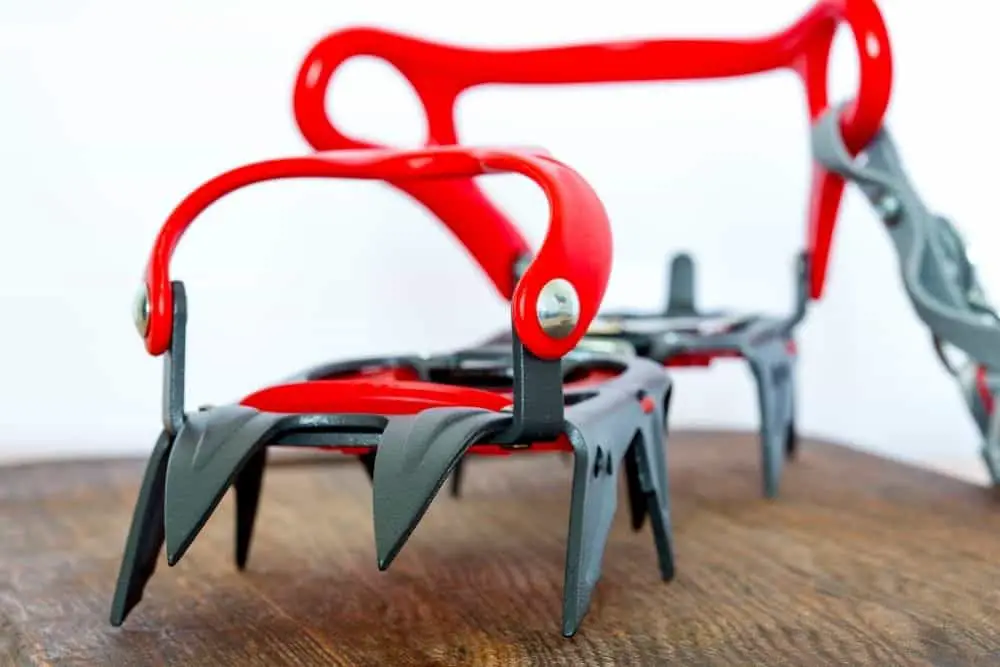
Strap-on crampons fit most hiking boots, so if you are unsure, you should probably get them. But, of course, they need to fit appropriately.
How Do You Put Crampons On Hiking Boots?

Wearing crampons on hiking boots can be a bit of work at first, but once you know it, you should not have trouble fitting them afterward. Fitting the different crampon types has slight modifications, but it is nothing serious.
Fitting C1 crampons with hiking boots:
- Insert your hiking boots in the crampons and ensure that the heel binder and toe cage fit properly around the boots.
- Fasten the straps around and tighten up.
Fitting C2 crampons with hiking boots:
- Wear the crampons over the hiking boots and ensure the front of the boots enter the toe cage.
- Lock the heel clip on your hiking boots’ heel welt.
- Fasten the straps of the crampons over your hiking boots.
Fitting C3 crampons with hiking boots:
- Put your hiking boots into your crampons and ensure that the crampon’s toe cage fits the toe welt of your boots.
- Lock the crampon’s heel clip on your hiking boots’ heel welt.
- Fit the crampon’s straps around your hiking boots and fasten.
Conclusion
Hiking during the snowy season or on slippery terrain without the right gear can be risky and dangerous. This is why you need to reinforce your hiking boots with the right accessories, and one of them is crampons.
You can wear crampons with hiking boots, and they are compatible as well. Wearing crampons with hiking boots helps to enhance traction and ensure safer hikes on the trail.
When choosing crampons for hiking boots, you need to consider their compatibility level, the terrain, and the activity. You should pair them based on their grade.
In addition, you should consider if they fit well so they don’t fall off on the trail. When walking with crampons, you should always walk with one foot ahead of the other for safety.

